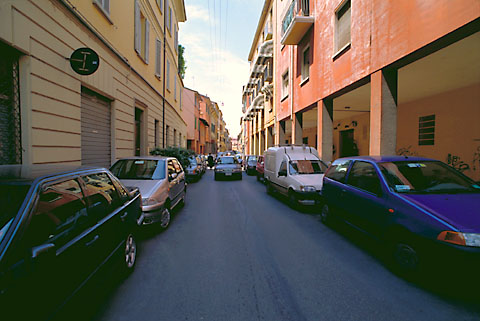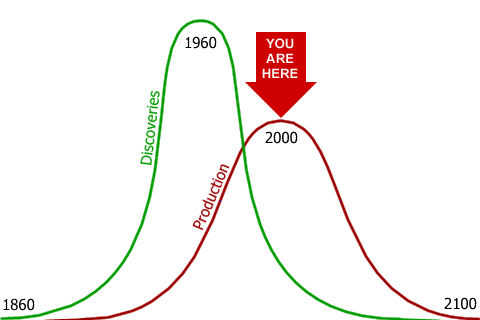  The streets of Bologna, Italy, are completely overrun by cars.
The Effects of Cars on CitiesI believe that the industrialized nations made a terrible mistake when they turned to the automobile as an instrument of increased freedom and opportunity. This trend began in the United States and has reached its highest expression there, so the American urban automobile is a useful casebook example. I see the following problems as at least partially caused or sustained by the urban automobile.Social IsolationThe automobile has isolated the young, the elderly, and others who cannot drive. This problem is particularly acute in suburban areas where there is no other means of transport.Social InsulationPeople in cars are not part of the landscape through which they pass. They don two tons of glass and steel armor from which they gaze out upon the scene. Drivers have no investment in what is happening and no sense of responsibility. This has led to toleration of appalling conditions in the inner city. People on foot or bicycle or public transport cannot so easily deny or ignore the conditions around them and are more likely to feel a sense of responsibility for the environments in which they find themselves. This tends to make deterioration in social conditions a self-correcting condition.Death of Street LifeStudies have shown very clearly that as automobile traffic on a street increases, social life on the street dies. The noise, danger, and pollution slowly drive people from the street. On streets with really heavy traffic, people do not even inhabit the rooms that front on the street. They make every effort to shut the street out of their lives.Donald Appleyard's Livable Streets documents his definitive research into the impact of the urban automobile on casual social contact within neighborhoods. Appleyard clearly shows that the level of traffic inversely correlates with the level of social contact. As traffic on a street increases, people retreat from the street and attempt to shut it out of their lives. Traffic noise makes conversation at normal levels difficult or impossible and steals the usual opportunities for casual interaction on the street. Residents rarely encounter their neighbors and often do not even know who their neighbors are. This leads to a gradual breakdown in the sense of community in the affected block. In Venice, people do not look over their shoulders because they know nothing is about to run them down. People relax and let down their guard. They are more willing to meet strangers and chat. This leads to a very pleasant feeling in the streets, which are full of people and therefore quite safe. The removal of the automobile from the urban environment will do much to help restore a sense community, something Americans have only recently realized that they were missing, as evinced by the surging interest in the New Urbanism, whose primary objective is to restore community by repairing the public realm.
DangerEvery year in America, more than 40,000 people are killed in automobile accidents. Far more are seriously injured. Many of the victims are children; the car is the leading cause of death among the young. Automobile accidents are the leading cause of lost life-expectancy in the US. In some developing nations, death-by-auto is the leading cause of death after intestinal infections. About 15,000,000 people have now been killed in traffic accidents worldwide.NoiseIn most cities, traffic is the largest source of noise. In the pedestrian precincts of Amsterdam and Copenhagen, the loudest sounds are often people's footsteps. Venice is entirely free of automotive noise, and the noise from passenger and freight boats is a minor problem. The use of slow battery-powered delivery vehicles in carfree cities should add very little to the noise burden. Once the cars are gone, people tend to speak more softly and other noise also tends to diminish.PollutionAutomobiles are the main cause of terrible air quality in many cities in America, Europe, and Asia. Having now made considerable progress in the fight against industrial pollution, the European Union has decided to shift its emphasis to transport-related pollution, and the automobile in particular. Europe will soon have the world's toughest environmental standards for cars, and a strong demand-reduction policy is going to be developed to reduce congestion and pollution.StenchAir quality is so bad in cities like Bangkok and Jakarta that the stench of combustion byproducts is overwhelming. It is repellent to be on the streets of these cities except late at night when the air has cleared some.Energy Use We're going to start running short of oil within a decade, two at most
Wasted TimeEvery week we hear a new estimate of the economic value of time lost to traffic congestion. The numbers are always numbingly large.Shattered ParentsThe economic value of time lost to traffic congestion is enormous, but the consequences for family life may be more significant. Parents arriving home from a hard day's work followed by an exhausting and infuriating struggle in traffic are hardly in the right frame of mind to enjoy the little time they have with their kids.Economic BurdenThe per-mile cost of transportation by automobile in America has increased only moderately during the past 30 years (largely due to rising insurance premiums). But more people are driving more miles each year, and the national income consumed by the automobile is increasing.Runaway Road CoverageAs more and more people try to live in the same city (for the sake of argument, within a one-hour drive of each other), something odd happens. If the city depends on road-based transport, the area covered by the road system increases without limit once the population reaches around five million. Highway and street rights-of-way must expand to cover all available ground in order to carry the volume of traffic required to keep the entire population within an hour's drive of one another. This situation is being approached in the auto-centric cities of the American West and South, where up to 70% of downtown land is devoted to the automobile. Unless computerized highways can increase the traffic density and average speeds, such cities cannot continue to grow while still remaining a single city. At some point, the distances and travel times increase so much that the area must be regarded as a group of adjoining urban areas and not a single city, with resultant limitations on social and economic activities. One can make a strong argument that this has already happened in the Los Angeles metropolitan region. Only metro systems can keep really large populations within a one-hour travel time, as in Hong Kong.Two Billion More Cars?Roughly two billion people use about 500 million automobiles in the world. The exact numbers are not important. The other four billion inhabitants of the planet seem eager to obtain this "improvement" in their lives. They should be advised of the costs and encouraged to think about better solutions. If the American rate of automobile ownership becomes the norm worldwide, we will someday have three billion cars. Can we find enough resources to build these cars? Can we find the gasoline to run them? Can we tolerate the stink, the noise, the danger, and the climate change? Or is there a better way? |
Continue on to Fixing Transport
Back to More
Return Home
About the book: Carfree Cities
E-mail
carfree.com
Copyright ©1996-2002 J.Crawford